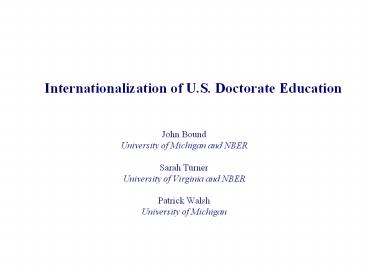Internationalization%20of%20U.S.%20Doctorate%20Education - PowerPoint PPT Presentation
Title:
Internationalization%20of%20U.S.%20Doctorate%20Education
Description:
Economics. Trends in funding for university science. Theoretical Motivation ... Changes in home country BA production yield increases in doctorate attainment ... – PowerPoint PPT presentation
Number of Views:42
Avg rating:3.0/5.0
Title: Internationalization%20of%20U.S.%20Doctorate%20Education
1
Internationalization of U.S. Doctorate Education
- John Bound
- University of Michigan and NBER
- Sarah Turner
- University of Virginia and NBER
- Patrick Walsh
- University of Michigan
2
Research Question
- What explains the rise in the representation of
foreign students among PhD recipients from U.S.
universities? - What determines the level and change in the
distribution across countries in the number of
U.S. doctorate recipients? - What effect does the rise have on the U.S. and on
foreign economies?
3
Empirical Starting PointsOverall
4
Physical Sciences
5
Life Sciences
6
Engineering
7
Economics
8
Trends in funding for university science
9
Theoretical Motivation(Borrowing from Roy Model)
10
Predictions from Theory
- Cross section
- Who comes? Those with limited higher education
systems will be relatively likely to pursue
graduate study at a U.S. university - Where do they go? Those with options relatively
close to those in the U.S. will be among those
with admission offers from some of the best
programs in the U.S. - Over time
- Demand shocks. Changes in home country BA
production yield increases in doctorate
attainment from U.S. universities. - Supply shocks. Funding shocks to the U.S.
graduate education market will yield relatively
larger changes in PhDs awarded to those from
countries where demand is relatively elastic. - Networks matter.
11
EvidenceCross-Sectional BA and PhD Degrees
12
Representation of Doctorate Recipients at Top-5
Programs(Physics)
13
Representation of Doctorate Recipients at Top-5
Programs(Economics)
14
1980, Science Engineering PhDs
15
1996, Science Engineering PhDs
16
Country-Specific Trends (Physical Sciences)
17
Country-Specific Trends by Program
Quality(Physics)
18
Growth in undergraduate degree attainment
19
Changes in BA Degrees and PhD Degrees Conferred
from U.S. Institutions
20
The China Case
21
Understanding degree attainment among U.S.
students
22
Share of Growth in US PhDs by Source Country
23
Physics by program rank and year of graduate
school entry
24
Average Annual IncreaseReal Earnings
25
Conclusion
- In the cross-section, representation and sorting
by program quality varies with home country
options selection is greater when options are
close to those in the U.S. - Demand side changes generated by dramatic
growth in undergraduate degree attainment in
countries like China and South Korea and
political developments in China and Eastern
Europe can explain much but not all -- of the
rise in PhDs awarded to foreign students by U.S.
institutions. - Labor market and returns to science have not
provided strong incentives for U.S. students to
enter science and engineering.
26
Further Thoughts
- Simple economic factors can explain increased
internationalization of doctoral education and
the Science and Engineering workforce. If there
are significant agglomeration effects, increased
internationalization will increase TFP. - Is the increased presence of foreigners in U.S.
PhD programs and in the U.S. scientific workforce
a good thing for the U.S.? The simple answer has
to be yes. More research at lower prices. - What about sending countries? While there is a
discussion of brain drain in various foreign
countries, there is some circulation of
scientists back to their countries of origin.
Indeed, some countries have policies that
explicitly capitalize on this (e.g. Israel).
Also, the presence of the U.S. market provides
incentives for foreign students and for foreign
systems of higher education. - Are there losers? Yes. (1) U.S. students who
might want to become scientists. (2) Possibly
U.S. undergraduates with foreign TAs, in the
absence of monitoring of communication skills.
27
Incentives from the labor market































